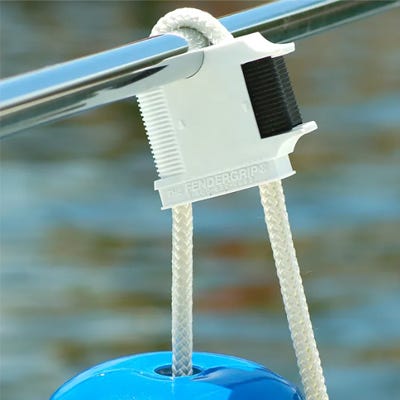Mooring
Protecting your boat at the dock is an important part of boat ownership. Lines must be secured properly, fenders must be mounted at the proper level, and all your hardware has to be up to the task. » Read More
Learn More About Mooring
Contents
The Importance of Proper Mooring
It’s important to keep your boat safe at the dock. Whether you’re leaving the boat at the marina unattended for a few days in between use, or just tying it up for lunch at your favorite dockside eatery, it’s important to take the proper steps to protect your boat.
There are multiple pieces of boat mooring equipment, including dock lines, cleats, fenders, and shackles. All of these must be in working condition to avoid your boat rubbing up against the dock, breaking loose from the dock, or even worse, getting stuck under the dock.
Types of Mooring
There are multiple ways to store your boat, ranging from docks with mooring whips to mooring fields, as well as lifts and dry storage. Docks are extremely common, leading to many great accessories that make mooring your boat at a dock easier. A mooring is any place where a boat is stored in the water. There are different types of mooring. Read More
There are multiple ways to store your boat, ranging from docks with mooring whips to mooring fields, as well as lifts and dry storage. Docks are extremely common, leading to many great accessories that make mooring your boat at a dock easier. A mooring is any place where a boat is stored in the water. There are different types of mooring.
In the U.S., the most common is dock mooring at a marina or residence. Another popular method is swing mooring. Swing mooring involves permanent anchors that are attached to a floating buoy, called a mooring buoy, that you tie your boat off to. Typically, groups of these anchors are placed in calm areas called mooring fields so multiple boats can tie off to different mooring buoys at the same time.
There is a difference between mooring and docking, but the terms are frequently used interchangeably.
Dock Mooring Cleats
Strong cleats are critical for mooring your boat at a dock. Whether it be short-term or long-term, high-quality and properly installed cleats are important. There are a few things to consider when you’re buying cleats for your boat. The first is the size of your boat. A 50-foot Viking is going to require a different size boat cleat than a 16-foot runabout. Although there’s no rule of thumb for cleat sizes, look at other boats of similar size to yours. Read More
Strong cleats are critical for mooring your boat at a dock. Whether it be short-term or long-term, high-quality and properly installed cleats are important. There are a few things to consider when you’re buying cleats for your boat. The first is the size of your boat. A 50-foot Viking is going to require a different size boat cleat than a 16-foot runabout. Although there’s no rule of thumb for cleat sizes, look at other boats of similar size to yours.
Another factor in buying cleats is what size line you are going to use. For every 1/16” diameter line, your cleat should be 1 inch from tip to tip. By this rule, a 3/8” line requires a 6-inch cleat, while a 1/2” line requires an 8-inch cleat, and so forth.
Cleats come in different materials, such as stainless steel, galvanized steel, and heavy-duty nylon. Stainless is stronger than nylon but heavier and more expensive. Nylon is a cheap alternative that is perfectly suited for smaller boats.
Remember to properly install your cleats. The strength of your lines and cleats is a moot point if the hardware fastening them down is not strong enough. Boat cleats should be through bolted and installed with a backing plate when possible. Be sure to properly seal your hardware so your coring does not become subject to moisture.
Docking and Mooring Lines
The correct maritime term for a rope is “line.” Once the rope is placed in a boat or used on the water, it becomes a line. Typically lines are measured and used for certain things such as dock lines, anchor lines, and fender lines. Dock lines are an important part of mooring your boat at the dock.Read More
The correct maritime term for a rope is “line.” Once the rope is placed in a boat or used on the water, it becomes a line. Typically lines are measured and used for certain things such as dock lines, anchor lines, and fender lines. Dock lines are an important part of mooring your boat at the dock.
The line size you need for mooring depends on the size of your boat, according to the following guidelines:
- 3/8” line for boats up to 27 feet
- 1/2” line for boats up to 36 feet
- 5/8” line for boats up to 45 feet
- 3/4” line for boats up to 54 feet
This works out to be 1/8” of line diameter for every 9 feet of boat.
Bow, Stern, and Spring Lines for Mooring
At a minimum, you should have four lines for permanent docking. A bow line, stern line, and two spring lines. On marina docking with pilings on either side, you may want two bow lines and two stern lines. Bow and stern lines should be roughly two-thirds of the boat's length, while spring lines should be about the same length as your boat. Read More
At a minimum, you should have four lines for permanent docking. A bow line, stern line, and two spring lines. On marina docking with pilings on either side, you may want two bow lines and two stern lines. Bow and stern lines should be roughly two-thirds of the boat's length, while spring lines should be about the same length as your boat.
Bow lines keep the boat from moving both side to side as well as fore and aft. Spring lines help keep the boat from moving fore and aft. Dock lines do not need to be too tight, as to allow for tidal swings and the lines to absorb movement. Make sure the lines are tight enough to stop the boat from being trapped under the dock, as this can cause your boat to sink when the tide comes up.
Dock Mooring Line Materials
Nylon is the best material for dock lines, as it is strong, UV resistant, and can stretch to absorb shock. Polypropylene is an alternative to nylon, but it is not as resistant to UV rays and will degrade quickly. A braided line is commonly used on dock lines as it looks nice and is easy to handle. Three-strand nylon rope is commonly used as an anchor line as it is not as prone to snagging on obstructions. Three strand is, however, not as easy to handle. Read More
Nylon is the best material for dock lines, as it is strong, UV resistant, and can stretch to absorb shock. Polypropylene is an alternative to nylon, but it is not as resistant to UV rays and will degrade quickly. A braided line is commonly used on dock lines as it looks nice and is easy to handle. Three-strand nylon rope is commonly used as an anchor line as it is not as prone to snagging on obstructions. Three strand is, however, not as easy to handle.
It’s important to make sure your lines won’t rub on anything that may chafe them, which can greatly reduce line strength. Lines should be inspected with every use and should be replaced after several years. There are different types of dock lines. Transient lines are dock lines that are looped at one end but not the other. This allows you to loop the line around a cleat on one end, and tie it off on the other.
Permanent dock lines are looped on both ends, this allows for the lines to be simply attached on either end, removing the need for knots or having to worry about consistency to maintain a safe distance from the dock.
Fenders and Bumpers for Boat Mooring
Fenders and bumpers are an important part of protecting your boat. They are cushions to protect your boat from rubbing or bumping the dock. Historically, they were made of discarded lines on sailing vessels. Modern fenders are typically made out of rubber, foam, or plastic. Fenders and bumpers are two different terms that are sometimes improperly used. Fenders are mounted to the boat, while bumpers are mounted to the dock. They serve the same purpose, but the terminology can be important to some in the boating community. Read More
Fenders and bumpers are an important part of protecting your boat. They are cushions to protect your boat from rubbing or bumping the dock. Historically, they were made of discarded lines on sailing vessels. Modern fenders are typically made out of rubber, foam, or plastic. Fenders and bumpers are two different terms that are sometimes improperly used. Fenders are mounted to the boat, while bumpers are mounted to the dock. They serve the same purpose, but the terminology can be important to some in the boating community.
It’s important that they are mounted at the proper level, as they are useless if mounted too high or low. When choosing the correct height, observe where your boat may rub against the dock and place the bumper or fender at that level. Fenders are frequently used in temporary docking or rafting up with other boats. On permanent slips, bumpers can be installed by the tenant or owner to protect your specific boat.
Boat Fender Clips and Cleats
There are many different accessories to make storing your boat easier. Fender clips and fender cleats make it easy to adjust your bumpers and fenders to the correct height and mount them without using your mooring cleats. Portable cleats can also be used for this by turning your rod holder into a portable cleat. Read More
There are many different accessories to make storing your boat easier. Fender clips and fender cleats make it easy to adjust your bumpers and fenders to the correct height and mount them without using your mooring cleats. Portable cleats can also be used for this by turning your rod holder into a portable cleat.
There are many different aspects of the boat mooring basics and the equipment involved. Keeping your boat safe and secure will allow you to enjoy many days on the water.



